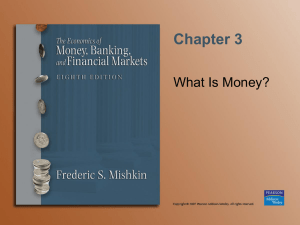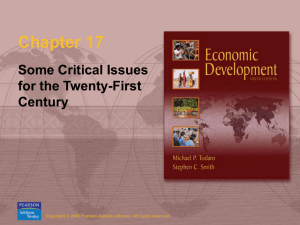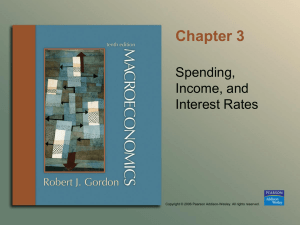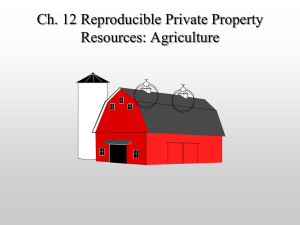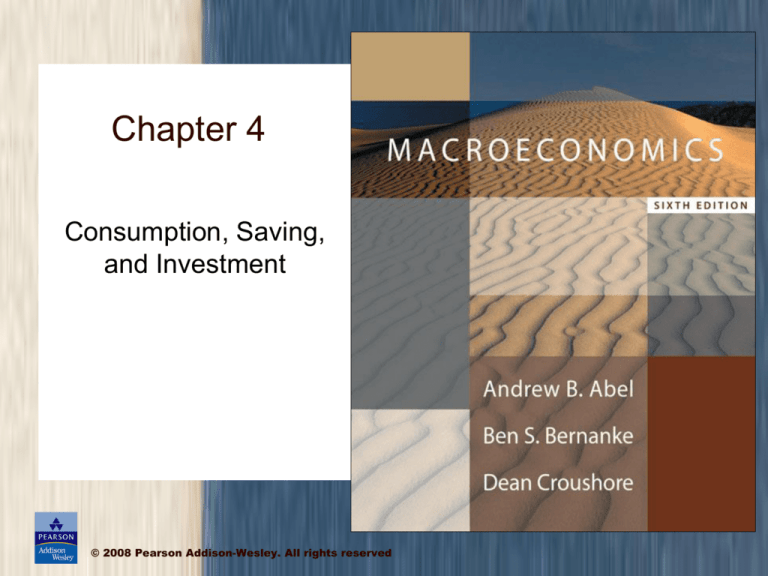
Chapter 4
Consumption, Saving,
and Investment
© 2008 Pearson Addison-Wesley. All rights reserved
Chapter Outline
• Consumption and Saving
• Investment
• Goods Market Equilibrium
© 2008 Pearson Addison-Wesley. All rights reserved
4-2
Consumption and Saving
• The importance of consumption and saving
– Desired consumption: consumption amount desired by
households
– Desired national saving: level of national saving when
consumption is at its desired level:
Sd = Y – Cd – G
(4.1)
© 2008 Pearson Addison-Wesley. All rights reserved
4-3
Consumption and Saving
• The consumption and saving decision of an individual
– A person can consume less than current income (saving is
positive)
– A person can consume more than current income (saving is
negative)
© 2008 Pearson Addison-Wesley. All rights reserved
4-4
Consumption and Saving
• The consumption and saving decision of an individual
– Trade-off between current consumption and future
consumption
• The price of 1 unit of current consumption is 1 + r units of future
consumption, where r is the real interest rate
• Consumption-smoothing motive: the desire to have a relatively
even pattern of consumption over time
© 2008 Pearson Addison-Wesley. All rights reserved
4-5
Consumption and Saving
• Effect of changes in current income
– Increase in current income: both consumption and saving
increase (vice versa for decrease in current income)
– Marginal propensity to consume (MPC) = fraction of
additional current income consumed in current period;
between 0 and 1
– Aggregate level: When current income (Y) rises, Cd rises,
but not by as much as Y, so Sd rises
© 2008 Pearson Addison-Wesley. All rights reserved
4-6
Consumption and Saving
• Effect of changes in expected future income
– Higher expected future income leads to more consumption
today, so saving falls
© 2008 Pearson Addison-Wesley. All rights reserved
4-7
Consumption and Saving
• Application: consumer sentiment and forecasts of
consumer spending
– Do consumer sentiment indexes help economists forecast
consumer spending?
– Data do not seem to give much warning before recessions
(Fig. 4.1)
© 2008 Pearson Addison-Wesley. All rights reserved
4-8
Figure 4.1 University of Michigan Index of Consumer
Sentiment, January 1978—December 2005
© 2008 Pearson Addison-Wesley. All rights reserved
4-9
Consumption and Saving
• Application: consumer sentiment and forecasts of
consumer spending
– Data on consumer spending are correlated with data on
consumer confidence (Fig. 4.2)
© 2008 Pearson Addison-Wesley. All rights reserved
4-10
Figure 4.2 University of Michigan Index of Consumer Sentiment
and Consumption Spending January 1978—December 2005
© 2008 Pearson Addison-Wesley. All rights reserved
4-11
Consumption and Saving
• Application: consumer sentiment and forecasts of
consumer spending
– Data on consumer spending are correlated with data on
consumer confidence (Fig. 4.2)
– But formal statistical analysis shows that data on consumer
confidence do not improve forecasts of consumer spending
based on other macro data
© 2008 Pearson Addison-Wesley. All rights reserved
4-12
Consumption and Saving
• Effect of changes in wealth
– Increase in wealth raises current consumption, so lowers
current saving
© 2008 Pearson Addison-Wesley. All rights reserved
4-13
Consumption and Saving
• Effect of changes in real interest rate
– Increased real interest rate has two opposing effects
• Substitution effect: Positive effect on saving, since rate of
return is higher; greater reward for saving elicits more saving
• Income effect
– For a saver: Negative effect on saving, since it takes less saving
to obtain a given amount in the future (target saving)
– For a borrower: Positive effect on saving, since the higher real
interest rate means a loss of wealth
• Empirical studies have mixed results; probably a slight increase
in aggregate saving
© 2008 Pearson Addison-Wesley. All rights reserved
4-14
Consumption and Saving
• Effect of changes in real interest rate
– Taxes and the real return to saving
• Expected after-tax real interest rate:
ra-t = (1 – t)i – e
© 2008 Pearson Addison-Wesley. All rights reserved
(4.2)
4-15
Table 4.1 Calculating After-Tax Interest Rates
© 2008 Pearson Addison-Wesley. All rights reserved
4-16
Consumption and Saving
• In touch with the macroeconomy: interest rates
– Discusses different interest rates, default risk, term structure
(yield curve), and tax status
– Since interest rates often move together, we frequently refer
to “the” interest rate
– Yield curve: relationship between life of a bond and the
interest rate it pays
© 2008 Pearson Addison-Wesley. All rights reserved
4-17
In Touch Yield Curve
© 2008 Pearson Addison-Wesley. All rights reserved
4-18
Consumption and Saving
• Fiscal policy
– Affects desired consumption through changes in current and
expected future income
– Directly affects desired national saving,
Sd = Y – Cd – G
© 2008 Pearson Addison-Wesley. All rights reserved
4-19
Consumption and Saving
• Fiscal policy
– Government purchases (temporary increase)
• Higher G financed by higher current taxes reduces after-tax
income, lowering desired consumption
• Even true if financed by higher future taxes, if people realize
how future incomes are affected
• Since Cd declines less than G rises, national saving (Sd = Y –
Cd – G) declines
• So government purchases reduce both desired consumption
and desired national saving
© 2008 Pearson Addison-Wesley. All rights reserved
4-20
Consumption and Saving
• Fiscal policy
– Taxes
• Lump-sum tax cut today, financed by higher future taxes
• Decline in future income may offset increase in current income;
desired consumption could rise or fall
© 2008 Pearson Addison-Wesley. All rights reserved
4-21
Consumption and Saving
• Fiscal policy
– Taxes
• Ricardian equivalence proposition
– If future income loss exactly offsets current income gain, no
change in consumption
– Tax change affects only the timing of taxes, not their ultimate
amount (present value)
– In practice, people may not see that future taxes will rise if taxes
are cut today; then a tax cut leads to increased desired
consumption and reduced desired national saving
© 2008 Pearson Addison-Wesley. All rights reserved
4-22
Consumption and Saving
• Application: a Ricardian tax cut?
– The Economic Growth and Tax Relief Reconstruction Act
(EGTRRA) of 2001 gave rebate checks to taxpayers and cut
tax rates substantially
– From the first quarter to the third quarter, government saving
fell $277 billion (at an annual rate) but private saving
increased $180 billion, so national saving declined only $97
billion, so about 2/3 of the tax cut was saved
© 2008 Pearson Addison-Wesley. All rights reserved
4-23
Consumption and Saving
• Application: a Ricardian tax cut?
– Most consumers saved their tax rebates and did not spend
them
– As a result, the tax rebate and tax cut did not stimulate much
additional spending by households
© 2008 Pearson Addison-Wesley. All rights reserved
4-24
Summary 5
© 2008 Pearson Addison-Wesley. All rights reserved
4-25
Investment
• Why is investment important?
– Investment fluctuates sharply over the business cycle, so we
need to understand investment to understand the business
cycle
– Investment plays a crucial role in economic growth
© 2008 Pearson Addison-Wesley. All rights reserved
4-26
Investment
• The desired capital stock
– Desired capital stock is the amount of capital that allows
firms to earn the largest expected profit
– Desired capital stock depends on costs and benefits of
additional capital
– Since investment becomes capital stock with a lag, the
benefit of investment is the future marginal product of capital
(MPKf)
© 2008 Pearson Addison-Wesley. All rights reserved
4-27
Investment
• The desired capital stock
– The user cost of capital
• Example of Kyle’s Bakery: cost of capital, depreciation rate,
and expected real interest rate
• User cost of capital = real cost of using a unit of capital for a
specified period of time = real interest cost + depreciation
uc = rpK + dpK = (r + d)pK
© 2008 Pearson Addison-Wesley. All rights reserved
(4.3)
4-28
Investment
• The desired capital stock
– Determining the desired capital stock (Fig. 4.3)
© 2008 Pearson Addison-Wesley. All rights reserved
4-29
Figure 4.3 Determination of the desired capital
stock
© 2008 Pearson Addison-Wesley. All rights reserved
4-30
Investment
• The desired capital stock
– Desired capital stock is the level of capital stock at which
MPKf = uc
– MPKf falls as K rises due to diminishing marginal productivity
– uc doesn’t vary with K, so is a horizontal line
© 2008 Pearson Addison-Wesley. All rights reserved
4-31
Investment
• The desired capital stock
– If MPKf > uc, profits rise as K is added (marginal benefits >
marginal costs)
– If MPKf uc, profits rise as K is reduced (marginal benefits <
marginal costs)
– Profits are maximized where MPKf = uc
© 2008 Pearson Addison-Wesley. All rights reserved
4-32
Investment
• Changes in the desired capital stock
– Factors that shift the MPKf curve or change the user cost of
capital cause the desired capital stock to change
– These factors are changes in the real interest rate,
depreciation rate, price of capital, or technological changes
that affect the MPKf (Fig. 4.4 shows effect of change in uc;
Fig. 4.5 shows effect of change in MPKf)
© 2008 Pearson Addison-Wesley. All rights reserved
4-33
Figure 4.4 A decline in the real interest rate
raises the desired capital stock
© 2008 Pearson Addison-Wesley. All rights reserved
4-34
Figure 4.5 An increase in the expected future
MPK raises the desired capital stock
© 2008 Pearson Addison-Wesley. All rights reserved
4-35
Investment
• Changes in the desired capital stock
– Taxes and the desired capital stock
• With taxes, the return to capital is only (1 – ) MPKf
• A firm chooses its desired capital stock so that the return
equals the user cost, so
(1 – )MPKf = uc, which means:
MPKf = uc/(1 – ) = (r + d)pK/(1 – )
© 2008 Pearson Addison-Wesley. All rights reserved
(4.4)
4-36
Investment
• Changes in the desired capital stock
– Taxes and the desired capital stock
• Tax-adjusted user cost of capital is uc/(1 – )
• An increase in τ raises the tax-adjusted user cost and reduces
the desired capital stock
© 2008 Pearson Addison-Wesley. All rights reserved
4-37
Investment
• Changes in the desired capital stock
– Taxes and the desired capital stock
• In reality, there are complications to the tax-adjusted user cost
– We assumed that firm revenues were taxed
» In reality, profits, not revenues, are taxed
» So depreciation allowances reduce the tax paid by firms, because
they reduce profits
– Investment tax credits reduce taxes when firms make new
investments
© 2008 Pearson Addison-Wesley. All rights reserved
4-38
Investment
• Changes in the desired capital stock
– Taxes and the desired capital stock
• In reality, there are complications to the tax-adjusted user cost
– Summary measure: the effective tax rate—the tax rate on firm
revenue that would have the same effect on the desired capital
stock as do the actual provisions of the tax code
– Table 4.2 shows effective tax rates for many different countries
© 2008 Pearson Addison-Wesley. All rights reserved
4-39
Table 4.2 Effective Tax Rate on Capital, 2005
© 2008 Pearson Addison-Wesley. All rights reserved
4-40
Investment
• Application: measuring the effects of taxes on
investment
– Do changes in the tax rate have a significant effect on
investment?
– A 1994 study by Cummins, Hubbard, and Hassett found that
after major tax reforms, investment responded strongly;
elasticity about –0.66 (of investment to user cost of capital)
© 2008 Pearson Addison-Wesley. All rights reserved
4-41
Investment
• Box 4.1: investment and the stock market
– Firms change investment in the same direction as the stock
market: Tobin’s q theory of investment
– If market value > replacement cost, then firm should invest
more
– Tobin’s q = capital’s market value divided by its replacement
cost
• If q < 1, don’t invest
• If q > 1, invest more
© 2008 Pearson Addison-Wesley. All rights reserved
4-42
Investment
• Box 4.1: investment and the stock market
– Stock price times number of shares equals firm’s market
value, which equals value of firm’s capital
• Formula: q = V/(pKK), where V is stock market value of firm, K
is firm’s capital, pK is price of new capital
• So pKK is the replacement cost of firm’s capital stock
• Stock market boom raises V, causing q to rise, increasing
investment
© 2008 Pearson Addison-Wesley. All rights reserved
4-43
Investment
• Box 4.1: investment and the stock market
– Data show general tendency of investment to rise when
stock market rises; but relationship isn’t strong because
many other things change at the same time
– This theory is similar to text discussion
• Higher MPKf increases future earnings of firm, so V rises
• A falling real interest rate also raises V as people buy stocks
instead of bonds
• A decrease in the cost of capital, pK, raises q
© 2008 Pearson Addison-Wesley. All rights reserved
4-44
Investment
• From the desired capital stock to investment
– The capital stock changes from two opposing channels
• New capital increases the capital stock; this is gross
investment
• The capital stock depreciates, which reduces the capital stock
© 2008 Pearson Addison-Wesley. All rights reserved
4-45
Investment
• From the desired capital stock to investment
– Net investment = gross investment (I) minus depreciation:
Kt+1 – Kt = It – dKt
(4.5)
where net investment equals the change in the capital stock
– Fig. 4.6 shows gross and net investment for the United
States
© 2008 Pearson Addison-Wesley. All rights reserved
4-46
Figure 4.6 Gross and net investment, 1929-2005
© 2008 Pearson Addison-Wesley. All rights reserved
4-47
Investment
• From the desired capital stock to investment
– Rewriting (4.5) gives It = Kt+1 – Kt + dKt
– If firms can change their capital stocks in one period, then
the desired capital stock (K*) = Kt+1
– So It = K* – Kt + dKt
(4.6)
© 2008 Pearson Addison-Wesley. All rights reserved
4-48
Investment
• From the desired capital stock to investment
– Thus investment has two parts
• Desired net increase in the capital stock over the year (K* – Kt)
• Investment needed to replace depreciated capital (dKt)
© 2008 Pearson Addison-Wesley. All rights reserved
4-49
Investment
• From the desired capital stock to investment
– Lags and investment
• Some capital can be constructed easily, but other capital may
take years to put in place
• So investment needed to reach the desired capital stock may
be spread out over several years
© 2008 Pearson Addison-Wesley. All rights reserved
4-50
Investment
• Investment in inventories and housing
– Marginal product of capital and user cost also apply, as with
equipment and structures
© 2008 Pearson Addison-Wesley. All rights reserved
4-51
Summary 6
© 2008 Pearson Addison-Wesley. All rights reserved
4-52
Goods Market Equilibrium
• The real interest rate adjusts to bring the goods market
into equilibrium
– Y = Cd + Id + G
(4.7)
goods market equilibrium condition
– Differs from income-expenditure identity, as goods market
equilibrium condition need not hold; undesired goods may
be produced, so goods market won’t be in equilibrium
© 2008 Pearson Addison-Wesley. All rights reserved
4-53
Goods Market Equilibrium
• Alternative representation: since
• Sd = Y – Cd – G,
•
S d = Id
© 2008 Pearson Addison-Wesley. All rights reserved
(4.8)
4-54
Goods Market Equilibrium
• The saving-investment diagram
• Plot Sd vs. Id (Key Diagram 3; text Fig. 4.7)
© 2008 Pearson Addison-Wesley. All rights reserved
4-55
Figure 4.7 Goods market equilibrium
© 2008 Pearson Addison-Wesley. All rights reserved
4-56
Goods Market Equilibrium
• The saving-investment diagram
– Equilibrium where Sd = Id
– How to reach equilibrium? Adjustment of r
– See text example (Table 4.3)
© 2008 Pearson Addison-Wesley. All rights reserved
4-57
Table 4.3 Components of Aggregate Demand for
Goods (An Example)
© 2008 Pearson Addison-Wesley. All rights reserved
4-58
Goods Market Equilibrium
• Shifts of the saving curve
– Saving curve shifts right due to a rise in current output, a fall
in expected future output, a fall in wealth, a fall in
government purchases, a rise in taxes (unless Ricardian
equivalence holds, in which case tax changes have no
effect)
– Example: Temporary increase in government purchases
shifts S left
– Result of lower savings: higher r, causing crowding out of I
(Fig. 4.8)
© 2008 Pearson Addison-Wesley. All rights reserved
4-59
Figure 4.8 A decline in desired saving
© 2008 Pearson Addison-Wesley. All rights reserved
4-60
Goods Market Equilibrium
• Shifts of the investment curve
– Investment curve shifts right due to a fall in the effective tax
rate or a rise in expected future marginal productivity of
capital
– Result of increased investment: higher r, higher S and I (Fig.
4.9)
© 2008 Pearson Addison-Wesley. All rights reserved
4-61
Figure 4.9 An increase in desired investment
© 2008 Pearson Addison-Wesley. All rights reserved
4-62
Goods Market Equilibrium
• Application: Macroeconomic consequences of the boom
and bust in stock prices
– Sharp changes in stock prices affect consumption spending
(a wealth effect) and capital investment (via Tobin’s q)
– Data in Fig. 4.10
© 2008 Pearson Addison-Wesley. All rights reserved
4-63
Figure 4.10 Real U.S. stock prices and the
ratio of consumption to GDP, 1987-2005
© 2008 Pearson Addison-Wesley. All rights reserved
4-64
Goods Market Equilibrium
• The boom and bust in stock prices
– Consumption and the 1987 crash
• When the stock market crashed in 1987, wealth declined by
about $1 trillion
• Consumption fell somewhat less than might be expected, and it
wasn’t enough to cause a recession
• There was a temporary decline in confidence about the future,
but it was quickly reversed
• The small response may have been because there had been a
large run-up in stock prices between December 1986 and
August 1987, so the crash mostly erased this run-up
© 2008 Pearson Addison-Wesley. All rights reserved
4-65
Goods Market Equilibrium
• The boom and bust in stock prices
– Consumption and the rise in stock market wealth in the
1990s
• Stock prices more than tripled in real terms
• But consumption was not strongly affected by the runup in
stock prices
© 2008 Pearson Addison-Wesley. All rights reserved
4-66
Goods Market Equilibrium
• The boom and bust in stock prices
– Consumption and the decline in stock prices in the early
2000s
• In the early 2000s, wealth in stocks declined by about $5 trillion
• But consumption spending increased as a share of GDP in that
period
© 2008 Pearson Addison-Wesley. All rights reserved
4-67
Goods Market Equilibrium
• The boom and bust in stock prices
– Investment and Tobin’s q
• Investment and Tobin’s q were not closely correlated following
the 1987 crash in stock prices
• But the relationship has been tighter in the 1990s and early
2000s, as theory suggests (Fig. 4.11)
© 2008 Pearson Addison-Wesley. All rights reserved
4-68
Figure 4.11 Investment and Tobin’s q, 19872005
© 2008 Pearson Addison-Wesley. All rights reserved
4-69
Key Diagram 3 The saving–investment
diagram
© 2008 Pearson Addison-Wesley. All rights reserved
4-70

